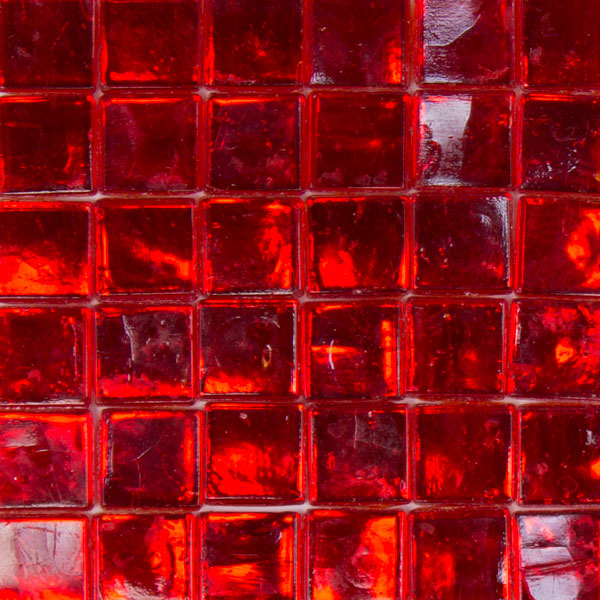
Primary-Red-JY16196


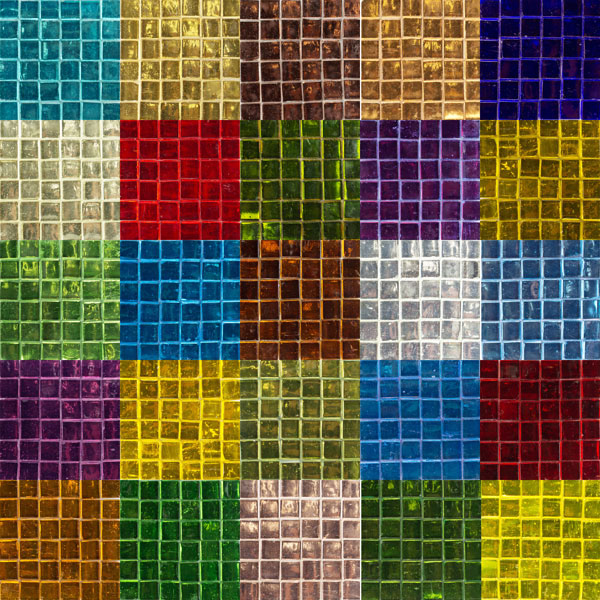
Colored Glass Mirror Tile 15mm is sold in sheets of 36 tiles face-mounted on clear plastic film. These are high-quality tile suitable for architectural installation indoors and outdoors. Avoid using mounting mesh. Avoid using in high chlorine and high sulfur environments or cleaning with acid.
Unlike the cheap crafting tiles sold by our competitors, the silver is more securely bonded into the back side of the glass, and the glass is actually colored (except for Gilt, Metallic, Brass, etc., where the metallic color comes from the alloy of silver used on the back). The use of colored glass is important because the surface coatings on the competitor’s product are easily scratched off the cheap clear glass. The foil on their product also comes off the glass when the tiles are cut. Not so with our mirror tile. You can cut them with confidence. Read our warning about the inferior mirror tile sold by competitors.
Price is per sheet of 36 tiles. Note that the sheet has a standard grout gap of 1/16 inch between tiles, but our photos show the tiles with no space between.
The manufacturer says that swimming pools are acceptable, but these are a new product, and long-term test data for use in pools does not exist. (Use in pools would be at customer risk and require best practices for grouting and sealing.)
With a standard grout gap of approximately 1/16 inch, one sheet of 36 tile will cover approximately 0.11 square foot. Nine (9) sheets covers 1 square feet.
Tile thickness is 1/8 inch nominal, the same as most of the glass mosaic tile we sell, which means that these can be used with other types and brands.
We recommend using the wheel-blade Mosaic Glass Cutter we sell to cut these and other types of glass mosaic tile. Unlike the cheaply made mirror-tiles sold be competitors, these tiles can be cut without causing the silver to fall of the glass.
These are mirror tiles, but there is waviness in the glass and silver which make the reflections distorted compared to a normal flat mirror. The purpose of the mirror is in these tiles is to reflect light not distinct images. Do not order if that is a problem. There is a fairly complete color palette available, and so an artist could render and image using only these mirror tiles, but they can be used with standard-finish varieties of glass tile.
For more advice on designing your mosaic project or cutting and grouting tile, please see our Mosaic Frequently Asked Questions page or our How To Mosaic blog or our Mosaic Information Guide.
; [product_table category=”colored-mirror-tile” widths=”auto,auto,12,12,20″] ;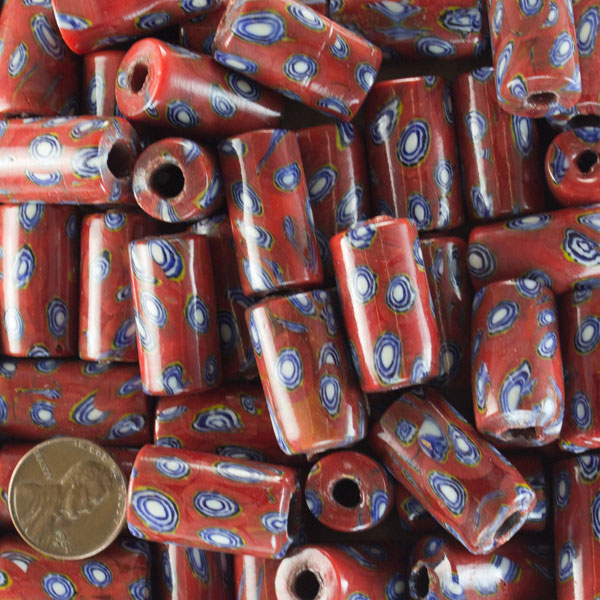
Red Cylinder Millefiori Glass Beads are chunky and roughly 1 inch long and sold in 2 ounce lots of approximately 7+ pieces. These beads are competitively priced by weight for use in mosaic art, but the diameters of these beads about 1/2 inch, which means they best pressed into thinset mortar or concrete instead of being glued to a flat surface.
This is a problematic question because beads was intended to be used as an accent instead of as area coverage, and the piece size can vary. One 2-ounce lot covers roughly 3 square inches.
Red Cylinder Millefiori Glass Beads are 1/2 inch in diameter, which is thicker than mosaic of the glass mosaic tile we sell. For this reason, these beads are best used by pressing into a bed of thinset mortar or a stepping stone mold filled with concrete.
These beads are too large to be cut using a Mosaic Glass Cutter because they won’t fit into the jaws. These beads are best used uncut. Lampwork beads often break unpredictably when cut with compression tools.
For more advice on designing your mosaic project or mounting, cutting, and grouting tile, please see our page of Mosaic Frequently Asked Questions or our Mosaic Information Guide, which lists instructional pages described by topic. We also post new articles about making mosaics at our How to Mosaic Blog.
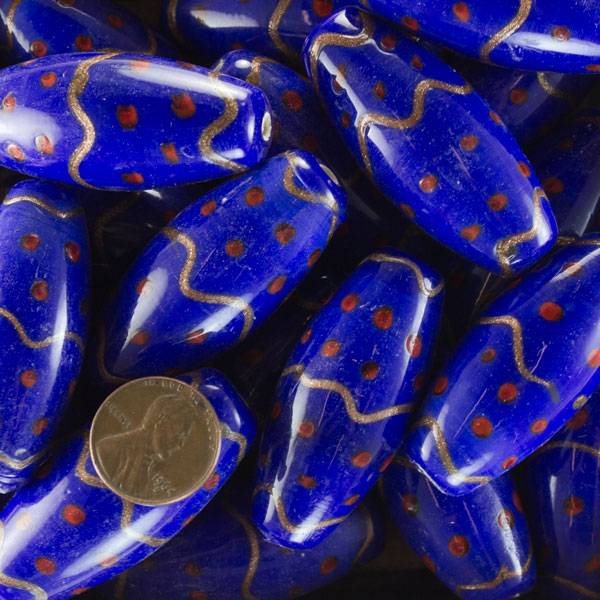
BIG Ovoid Blue Red Glass Beads are large and chunky and sold by the piece. These beads are GIGANTOSAURUS, which means they best pressed into mortar or concrete instead of being glued to a flat surface.
This is a problematic question because beads was intended to be used as an accent instead of as area coverage, and the piece size is large.
BIG Ovoid Blue Red Glass Beads are over 3/4 inch in diameter, which is thicker than mosaic of the glass mosaic tile we sell. For this reason, these beads are best used by pressing into a bed of thinset mortar or a stepping stone mold filled with concrete.
These beads are too large to be cut using a Mosaic Glass Cutter because they won’t fit into the jaws. These beads are best used uncut.
For more advice on designing your mosaic project or mounting, cutting, and grouting tile, please see our page of Mosaic Frequently Asked Questions or our Mosaic Information Guide, which lists instructional pages described by topic. We also post new articles about making mosaics at our How to Mosaic Blog.

Red Heart Glass Beads are very large 42mm (1.7 inch) and sold in lots of 2 pieces. These beads are competitively priced for use in mosaic art. They are about twice as thick as most of our brands of glass mosaic tile, and that means they will stick up above the surrounding tiles, but raised element can give the surface of your mosaic visual and tactile interest.
This is a problematic question because beads was intended to be used as an accent instead of as area coverage. One bead is about 1.7 inches across.
Red Heart Glass Beads are thicker than most of our glass tile, but they are still flat and easy to grout.
These beads are best used uncut.
For more advice on designing your mosaic project or mounting, cutting, and grouting tile, please see our page of Mosaic Frequently Asked Questions or our Mosaic Information Guide, which lists instructional pages described by topic. We also post new articles about making mosaics at our How to Mosaic Blog.
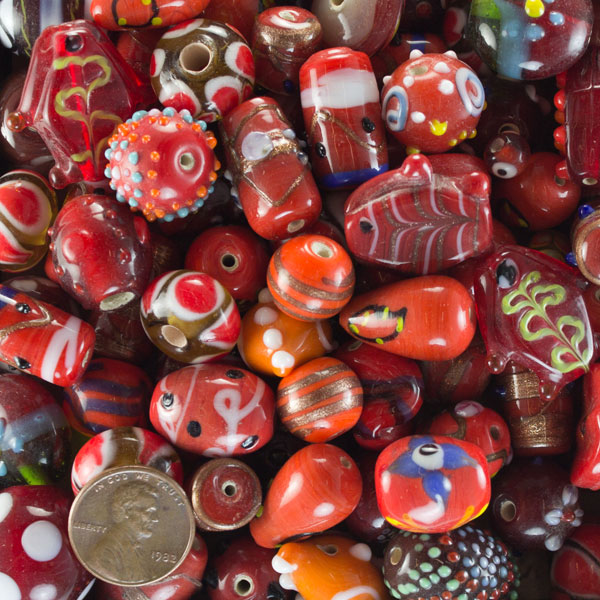
Red Dotted Lampwork Glass Beads are large and chunky and sold in 4 ounce assortments of approximately 18+ pieces. These beads are competitively priced by weight for use in mosaic art, but the diameters of most of these beads are 1/2 inch or more, which means they best pressed into mortar or concrete instead of being glued to a flat surface.
This is a problematic question because beads was intended to be used as an accent instead of as area coverage, and the piece size can vary. One 4-ounce assortment covers roughly 3+ square inches.
The Red Dotted Lampwork Glass Beads are usually 1/2 inch or larger in diameter, which is thicker than mosaic of the glass mosaic tile we sell. For this reason, these beads are best used by pressing into a bed of thinset mortar or a stepping stone mold filled with concrete.
These beads are too large to be cut using a Mosaic Glass Cutter because they won’t fit into the jaws. These beads are best used uncut.
For more advice on designing your mosaic project or mounting, cutting, and grouting tile, please see our page of Mosaic Frequently Asked Questions or our Mosaic Information Guide, which lists instructional pages described by topic. We also post new articles about making mosaics at our How to Mosaic Blog.
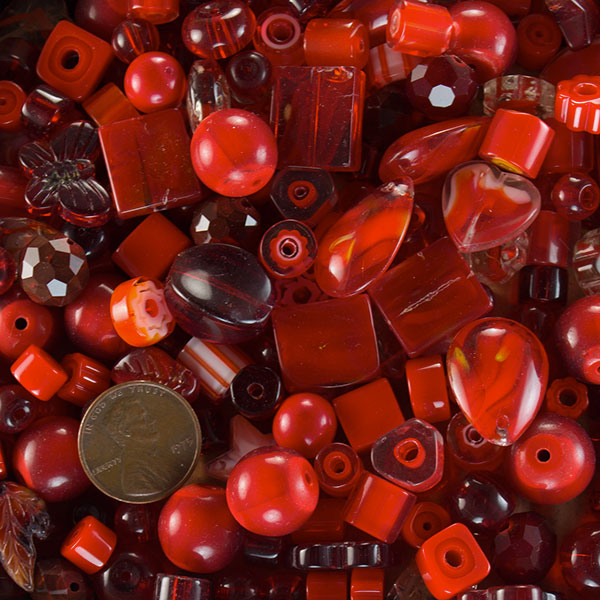
Cathay Red JTMG-24 Chunky Glass Beads are large and chunky and sold in 4 ounce assortments of approximately 20+ pieces. These beads are competitively priced by weight for use in mosaic art, but the diameters of most of these beads are 1/2 inch or more, which means they best pressed into mortar or concrete instead of being glued to a flat surface.
This is a problematic question because beads was intended to be used as an accent instead of as area coverage, and the piece size can vary. One 4-ounce assortment covers roughly 3+ square inches.
Cathay Red JTMG-24 Chunky Glass Beads are usually 3/8 inch or larger in diameter, which is thicker than mosaic of the glass mosaic tile we sell. For this reason, these beads are best used by pressing into a bed of thinset mortar or a stepping stone mold filled with concrete.
Some of these beads are too large to be cut using a Mosaic Glass Cutter because they won’t fit into the jaws. These beads are best used uncut.
For more advice on designing your mosaic project or mounting, cutting, and grouting tile, please see our page of Mosaic Frequently Asked Questions or our Mosaic Information Guide, which lists instructional pages described by topic. We also post new articles about making mosaics at our How to Mosaic Blog.
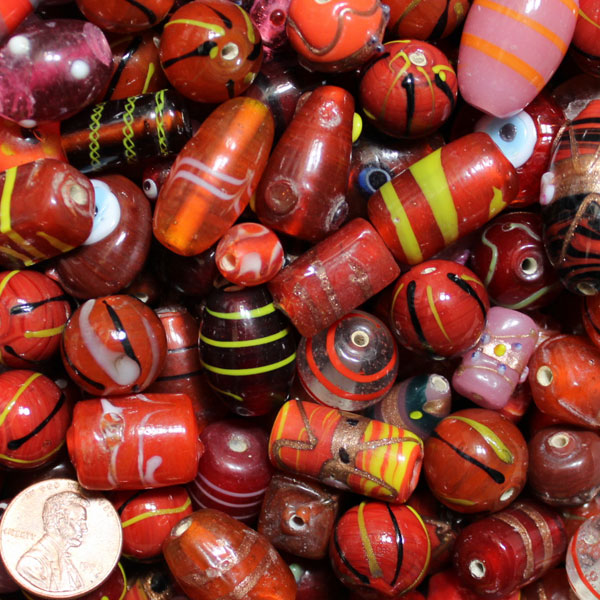
Red Lampwork Glass Beads are large and chunky and sold in 4 ounce assortments of approximately 20+ pieces. These beads are competitively priced by weight for use in mosaic art, but the diameters of most of these beads are 1/2 inch or more, which means they best pressed into mortar or concrete instead of being glued to a flat surface.
This is a problematic question because beads was intended to be used as an accent instead of as area coverage, and the piece size can vary. One 4-ounce assortment covers roughly 3+ square inches.
The Red Lampwork Glass Beads are usually 3/8 inch or larger in diameter, which is thicker than mosaic of the glass mosaic tile we sell. For this reason, these beads are best used by pressing into a bed of thinset mortar or a stepping stone mold filled with concrete.
Some of these beads are too large to be cut using a Mosaic Glass Cutter because they won’t fit into the jaws. These beads are best used uncut.
For more advice on designing your mosaic project or mounting, cutting, and grouting tile, please see our page of Mosaic Frequently Asked Questions or our Mosaic Information Guide, which lists instructional pages described by topic. We also post new articles about making mosaics at our How to Mosaic Blog.
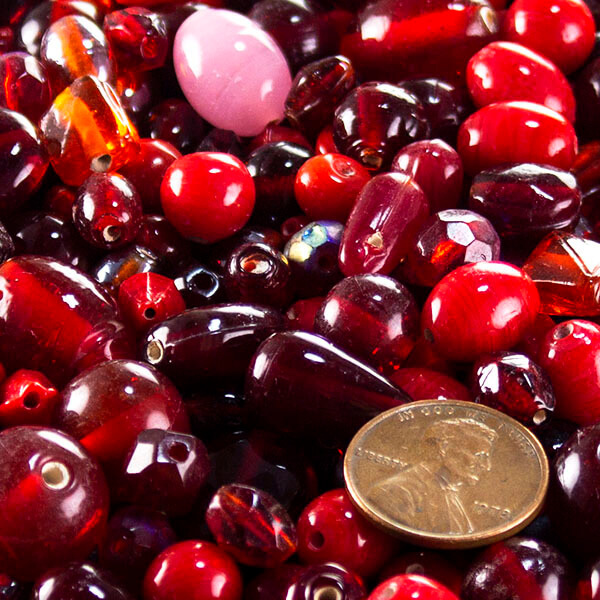
Red Assortment Small Glass Beads are smaller beads sold in 2 ounce assortments of approximately 60+ pieces. These beads are competitively priced by weight for use in mosaic art, and are generally small enough (6 to 12mm) to be glued to a flat surface.
This is a problematic question because beads was intended to be used as an accent instead of as area coverage, and the piece size can vary. One 2-ounce assortment covers roughly 2+ square inches.
The Red Assortment Small Glass Beads are usually smaller than most of our lampwork beads, and this means most of them can be glued to a flat surface with glass mosaic tile without sticking up too far. However, grouting any mosaic made from pieces of uneven thickness requires a little more effort and care than grouting a mosaic of tile of uniform thickness.
These beads are small enough to be used without the need to cut them.
For more advice on designing your mosaic project or mounting, cutting, and grouting tile, please see our page of Mosaic Frequently Asked Questions or our Mosaic Information Guide, which lists instructional pages described by topic. We also post new articles about making mosaics at our How to Mosaic Blog.
